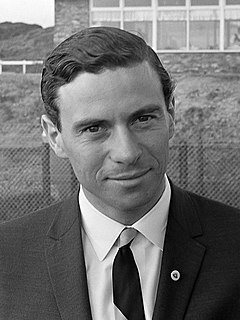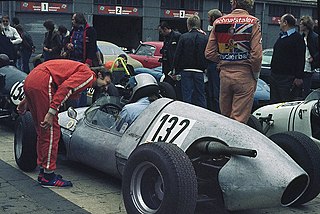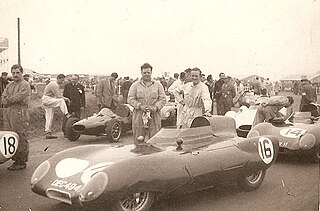
The Gemini name was used on a series of Formula Junior racing cars built by Chequered Flag Engineering of London between 1959 and 1963.

The Gemini name was used on a series of Formula Junior racing cars built by Chequered Flag Engineering of London between 1959 and 1963.
In 1959, Graham Warner, the principal of The Chequered Flag Car Sales, purchased the Moorland Mk 2, a Formula Junior car which had been constructed by Leslie Redmond in early 1959 from drawings supplied by Len Terry . [1] The car was renamed the Gemini Mk 1 and won on debut at Brands Hatch in September 1959. [2]


Having acquired the design rights, jigs and moulds for the Moorland, along with Redmond's services as designer, Warner formed a new company, Chequered Flag Engineering. [2] The Gemini Mk 2 was subsequently produced [2] and was first raced in a Formula Junior event at Brands Hatch in October 1959. [1]
It is believed that thirty Mk 2s were built, four powered by Ford Cosworths and all others by BMC A Series engines. [2]
The rear engined Gemini Mk 3 was introduced during 1960 and met with success in the hands of Tony Maggs, Geoff Duke and Peter Ashdown. [1] The Mk 3A of 1961 proved to be the only challengers to Cooper and Lotus in that year. [1] A total of eight Mk 3As were built in addition to the one prototype Mk 3. [2]
The Gemini Mk 4 was developed in 1962. [1] The car was of advanced design and featured inboard suspension, inboard brakes and two small radiators on each side of the car. [3] It was powered by a Cosworth modified Ford engine mated to a Renault Dauphine gearbox. [3] In 1963 the project was handed over to George Henrotte as the Gemini Mk 4A and production ended in the same year. [1]

Cosworth is a British automotive engineering company founded in London in 1958, specialising in high-performance internal combustion engines, powertrain, and electronics; for automobile racing (motorsport) and mainstream automotive industries. Cosworth is based in Northampton, England, with American facilities in Indianapolis and Mooresville, North Carolina.

James Clark Jr. OBE was a British Formula One racing driver from Scotland, who won two World Championships, in 1963 and 1965. A versatile driver, he competed in sports cars, touring cars and in the Indianapolis 500, which he won in 1965. He was particularly associated with the Lotus marque.

Brands Hatch is a motor racing circuit in West Kingsdown, Kent, England, United Kingdom. Originally used as a grasstrack motorcycle circuit on farmland, it hosted 12 runnings of the British Grand Prix between 1964 and 1986 and currently hosts many British and International racing events. The venue is owned and operated by Jonathan Palmer's MotorSport Vision organisation.
Ian Ewart Raby was a British racing driver from England. He participated in 7 World Championship Formula One Grands Prix, debuting on 20 July 1963 in the British Grand Prix, where he retired on Lap 60. He scored no championship points. He was a garage-owner in Brighton, Sussex trading as Empire Cars Ltd. As a privateer he came to Formula One late in life.
Stebro was a Canadian constructor of Formula Junior racing cars. The team also competed in one Formula One race, the 1963 United States Grand Prix, where their one car finished in seventh place.
Shannon Racing Cars was a Formula One constructor from the United Kingdom with Aiden Jones, formerly a mechanic for Prince Bira and Prince Chula, and Paul Emery as the principals. Using a car built by former Emeryson designer Emery and an old Coventry Climax engine, they participated in a single Grand Prix. Trevor Taylor drove for the team at the 1966 British Grand Prix, retiring early in the race. The car was then used for Formula 3 until 1969.

Formula Junior is an open wheel formula racing class first adopted in October 1958 by the CSI. The class was intended to provide an entry level class where drivers could use inexpensive mechanical components from ordinary automobiles. The idea to form the new class came from Count Giovanni "Johnny" Lurani who saw the need of a class for single-seater racing cars where younger drivers could take their first steps. It is often speculated that this class was founded as a reaction to Italy's lack of success in the 500cc Formula Three, and although Italian marques dominated the first year of the formula, they were soon overtaken by British constructors.
Brian Roger Hart was a British racing driver and engineer with a background in the aviation industry. He is best known as the founder of Brian Hart Limited, a company that developed and built engines for motorsport use.

Falcon Shells was a British company that produced specials/kit cars from 1956 until 1964.
Eric Harrison Broadley MBE was a British entrepreneur, engineer, and founder and chief designer of Lola Cars, the motor racing manufacturer and engineering company. He was arguably one of the most influential automobile designers of the post-war period, and over the years Lola was involved with many high-profile projects in Formula One, IndyCar, and sports car racing. Broadley sold Lola to Martin Birrane in 1999.

The Eagle Mk1, commonly referred to as the Eagle T1G, was a Formula One racing car, designed by Len Terry for Dan Gurney's Anglo American Racers team. The Eagle, introduced for the start of the 1966 Formula One season, is often regarded as being one of the most beautiful Grand Prix cars ever raced at the top levels of international motorsport. Initially appearing with a 2.7L Coventry Climax inline 4-cylinder engine, the car was designed around a 3.0L Gurney-Weslake V12 which was introduced after its first four races. In the hands of team boss Gurney, the Eagle-Weslake won the 1967 Belgian Grand Prix, making Dan Gurney only the second driver at the time, and one of only three to date, to win a Formula One Grand Prix in a car of their own construction. That win in Belgium still stands as the only win for a USA-built car as well as one of only two wins of an American-licensed constructor in Formula One.
Harley F. Copp, was an American car designer and automotive safety consultant.

John Crosthwaite was an English race car designer and engineer, active in both the United Kingdom and the United States.
The Heron was a Formula Junior racing car designed by Les Redmond and Syd Diggory. It was fitted with a Ford 105E engine.
Colchester Racing Developments produced Merlyn racing cars from 1960 to 1979. The company was founded by Clive Maskrey, Selwyn Hayward and continued by Hayward's brother, Clive. When the manufacture of Merlyn racing cars stopped, Clive Hayward continued to manufacture Merlyn parts as CRD Tool and Engineering Ltd. This company stopped trading in November 2015, but Clive Hayward continues to run Colchester Racing Developments, manufacturing Merlyn components and carrying out chassis repairs.

'The Motor' International Six Hour Saloon Car Race was the third round of the 1963 European Touring Car Challenge, and was held at Brands Hatch on the Grand Prix circuit, on 6 July.
Leonard E. Terry was an English racing car designer and engineer, known for his work with Lotus, BRM and Eagle. He also designed chassis for many other teams, including ERA and Aston Martin and produced his own car in which he competed.
Charles Lucas Engineering were manufacturers of Titan Formula cars from 1967 to 1976 and engines and components for racing cars. The company was renamed Titan Motorsport and Manufacturing Ltd after it ceased car manufacturing.
The Weslake V12 engine family is a series of four-stroke, 60-degree, naturally-aspirated, V-12 racing engine, designed, developed and produced by Weslake; between 1966 and 1992.

The Brabham BT5, and its evolution, the Brabham BT8, are sports racing cars manufactured and developed by Brabham in 1963 (BT5) and 1964 (BT8), respectively. It won a total of 4 races, and achieved 10 podium finishes.